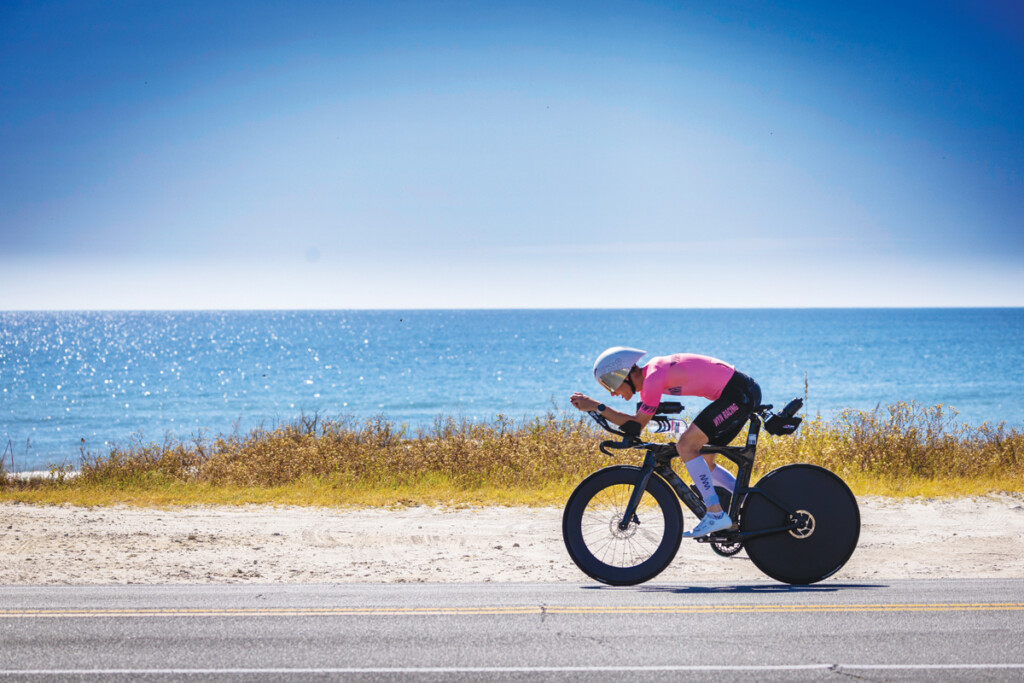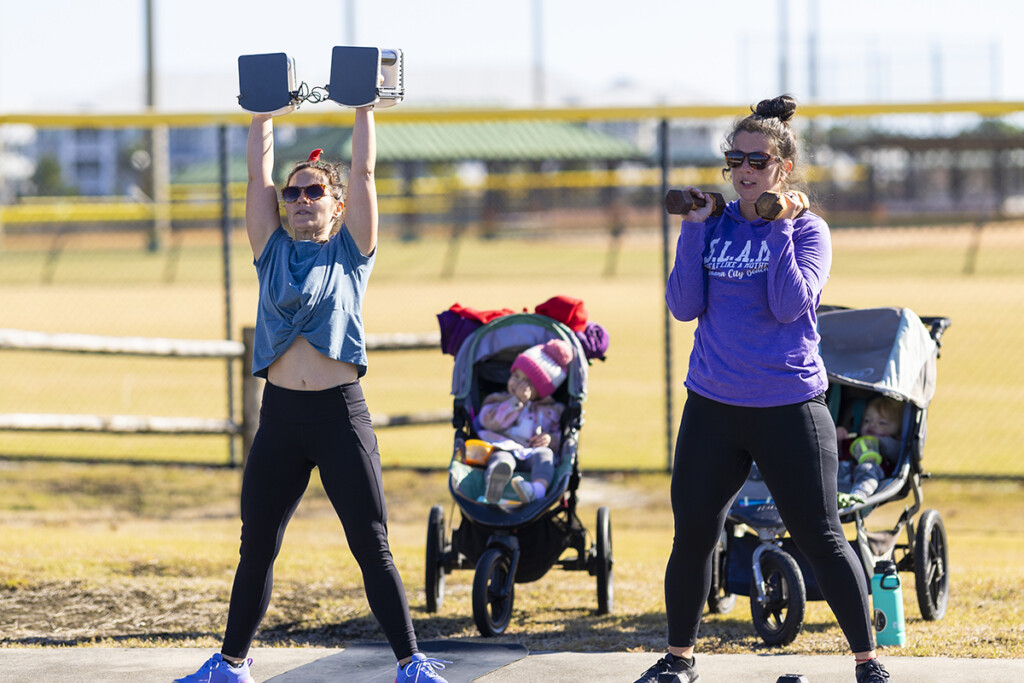Ironman Florida
Local triathletes define individual training routines to pave their way to the finish line

It was one small turn off a long, grueling road.
Alex Burgans had spent almost four hours and 26 miles fighting the third leg of the Ironman triathlon. When he rounded the corner at Pier Park, he could see the finish line, he could see the crowd, he could hear the cheers.
Among the cheering spectators was his fiancée, mom, aunt, grandma, and other friends and family members.
“It was super, super emotional,” he recalls, fighting back tears.
Behind Burgans was a 10-hour race day. The Ironman Florida triathlon race consists of a 2.4-mile swim in the Gulf of Mexico, followed by a 112-mile bike ride, and finished with a 26.2-mile run.
Over the public address system Burgans heard his finish announced: “Alex Burgans, you are an Ironman.”
One by one, hundreds of athletes would cross that finish line. Some would scream, some raise their fists in celebration, and some would break down in tears. Ironman Florida’s triathlon event has a way of breaking you down before letting you get to that finish line. More than 200 of the 1,700 who started the race didn’t reach the end.
The November race was one of two Ironman events hosted by Panama City Beach each year. A half-triathlon race takes place in May. Race director Ben Rousa says PCB has hosted the full Ironman for 27 years and the half-triathlon for 43 this year. The events attract up to 2,000 athletes each.
For Burgans, the 140.6 miles logged on race day made up just a fraction of the training miles it took to get to that finish line. Burgans worked with a coach to develop a balanced training regimen on a weekly basis. On a normal week he put in 10 hours of training that he split between the three legs of the race, some weeks that number went up to 12. All this while working his full-time job as an engineer.
Most of the biking is done on a bike trainer inside his Panama City home with a long ride outside of town on the weekends. On his runs, he often has his dad or fiancée riding a bike beside him to keep him company. Most of his swim training took place in the pool.
“I’ll try to get out to the beach and get a swim or two in the Gulf before the race,” he says.

Alex Burgans leaps over the first waves to start the swim portion of Ironman Florida. Photo by Mike Fender
For Burgans, training is essential. Like most, he says he didn’t realize how challenging triathlons would be until his first race.
“It’s a very humbling sport, and it tends to humble you very quickly,” he says. For the November race, he taped a sticker that said “believe” onto his bike frame for encouragement.
During that training, he had his mind on one goal—qualifying for the Men’s Ironman World Championships in Nice, France. After a fifth-place finish in his 25-29 age group at the November race, he earned that bid and plans to compete there in September.
After competing in five Ironman Florida full triathlons and countless other races Burgans is excited to see the hours and miles of training pay off.
“I’ve been chasing this dream since I was 19,” he says.
The first time he showed up to a pool to swim he couldn’t make it 25 yards. Now, he is thankful for the maturity that multiple races have provided him.
“I allow myself to soak in those moments to celebrate,” he says. “That last 200-yard stretch is everything.”

Margaret Tobey is all smiles as she crosses the Ironman Florida finish line, taking second place in her 25-29 age group and qualifying for the upcoming Women’s Ironman World Championship. Photo by Mike Fender
Like Burgans, Margaret Tobey, 28, also utilized a coach to fine tune her training for her first Ironman Florida event. The data scientist from Panama City Beach finished second in her age group and was the 16th fastest woman to complete the race.
Her efforts earned a bid to the Women’s Ironman World Championship in Hawaii this coming October. She said training in the heat and humidity of Panama City Beach should help her with similar conditions in Kona.
“I’ll probably train most of the year,” she says. “Then I’ll do the half-marathon in May, recover for a little bit before I rip up the distance before fall.”
To prepare for her first Ironman, Tobey trained for five months for 10 to 18 hours a week. She did most of her swimming in the pool at Frank Brown Park, with her running and biking outside on trails and roadways. To get to Ironman level, Tobey advises athletes to start with smaller sprints and Olympic triathlons with shorter distances, then work their way up.
“I think this will get you excited about racing and help encourage yourself more and more each time,” she says. “You have to learn to love the sport first.”

Jacksonville native Steven Lowenthal greets supporters as he finishes first in the Ironman Florida triathlon. Photo by Mike Fender
A majority of competitors are male and, Tobey says, it can be intimidating for new women entering the Ironman scene. Tobey hopes to encourage more women to compete in the future.
“I do find that women in the triathlons are really supportive of each other regardless of their goals” she says.
Patrick Chapin discovered Ironman by watching the championships in Hawaii on television when he was in his early 30s. He’s 57 now. A friend told him about a website to try that gave you training tips. So, he bought a bike and followed the training to his first race.
Chapin, who leads the Bay County Chamber of Commerce, says he is atypical to most Ironman athletes when it comes to training.
“I probably do 30 percent less training than the friends I have who compete,” he says.
And he doesn’t use a coach. Too, age has impacted his training approach.
“It takes a lot more recovery time,” he says. “And I try to do a lot more stretching.”
Because he likes running, he focuses more on that and does most of his bicycle training on an indoor trainer at his home. He trains on the weekends with long runs and long bike rides, slowly building up to race day. He trains for swimming in a pool with waterproof earbuds. The music helps fight the monotony.
Chapin puts Ironman training at the top of his difficulty list, outranking a rim to rim run across the Grand Canyon, a climb up Kilimanjaro, and all the ultra-marathons he has run.

Jennifer Sylvia, from Saint Johns, celebrates as she nears the finish line, taking second place in the triathlon’s female overall category. Photo by Mike Fender
“Training for an Ironman is harder than any of those,” he says. “It is just so grueling and so difficult. The Ironman itself is easier compared to the training.”
To get through the race Chapin takes a four-part compartmentalization approach. He starts with the swim, breaks the bike ride into two halves, and looks at the run as the final part. That keeps him from being overwhelmed with the task of doing 140.6 miles in one day.
Chapin says, at his age, he’s not planning to break any race records.
“I just try to enjoy it and soak everything in,” he says.
Over the years, he’s competed in Ironman events across the country and in Mexico. He has completed Ironman Florida five times. He tries to do at least one big Ironman or ultramarathon each year. He missed the November race in 2024 due to a shoulder injury but was there to cheer on friends. He plans to get back on the course this November to mark his 10th anniversary as a kidney donor, a milestone he hopes can inspire others.
“I’m dealing with one kidney,” he says. “So, if I can do this, you can do this.”

